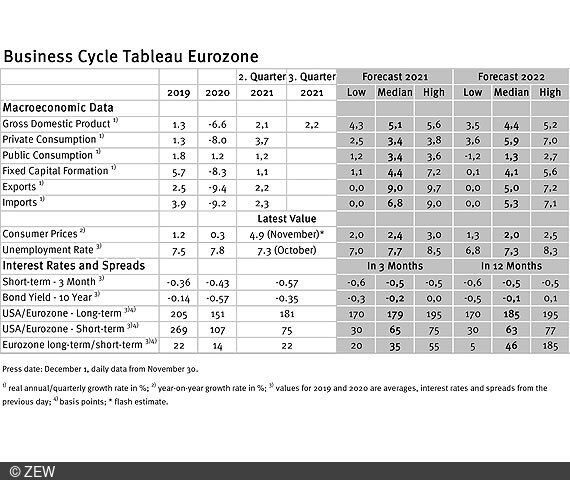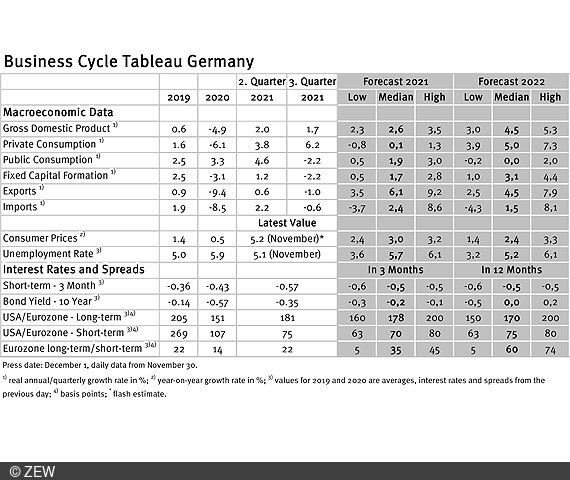Euro Area Weathers Pandemic Better than the German Economy
Business Cycle Tableaus by ZEW and Börsen-ZeitungNevertheless, Economists Forecast Lower Unemployment Rate for Germany
Economic experts expect the euro area economy to grow more strongly than the German economy. Inflation is also lower in the euro area than in Germany. Overall, however, inflation rates are reaching a new record level. This is the result of the business cycle tableaus by ZEW Mannheim and the German daily newspaper, Börsen-Zeitung.
The median forecast for real gross domestic product (GDP) growth in the euro area rises from 5.0 last month to currently 5.1 per cent. For 2022, the GDP forecast remains unchanged at 4.4 per cent. The GDP forecasts for the German economy, however, have fallen by 0.1 percentage points for both years and now stand at 2.6 per cent for the current year and 4.5 per cent for 2022.
Germany’s unemployment rate expected to decline further
According to these forecasts, it looks as if the German economy will weather the pandemic worse than the euro area as a whole, at least in terms of GDP growth. Looking at the labour market, the unemployment rate in Germany is likely to be 5.2 per cent next year, well below the euro area unemployment rate, which is forecast at 7.3 per cent. When taking the figures from Eurostat, the gap becomes even larger: according to their definition, Germany’s unemployment rate is currently about 1.7 to 1.8 percentage points lower than that calculated by the Federal Employment Agency.
Inflation rates reach new highs – can we expect a trend reversal?
The recovery from the economic slump at the beginning of the pandemic has led to a very strong increase in consumer price inflation since the beginning of the year. At 4.9 per cent in the euro area and 5.2 per cent in Germany, inflation rates reached new highs in November. However, experts still expect inflation rates to fall again in the coming year, although the forecasts have been raised somewhat. In 2022, the average annual inflation rate in the euro area is expected to be 2.0 per cent, which is precisely the target value of the European Central Bank. For Germany, inflation forecasts for next year have been raised from 2.1 per cent to 2.4 per cent. Compared to the current inflation rates and to the average values for 2021, the experts are thus not only expecting to see a reversal of the downward trend, but even a very strong decline over the course of next year. Moreover, they assume that monetary conditions will remain unchanged, as they still don’t expect to see a turnaround in monetary policy or in the bond market.
Business cycle tableaus by ZEW and Börsen-Zeitung
In cooperation with Börsen-Zeitung, ZEW has been publishing monthly business cycle tableaus for Germany and the eurozone with economic key figures and forecasts since 2013. Numerous banks and institutes publish reports on the current and prospective economic situation at different intervals. The information relevant for the tableau is filtered out of these publications to compute a median, minimum and maximum of the available forecasts for the current and subsequent year.
The monthly tableaus show current GDP forecasts, its main components, consumer prices, industrial production, unemployment rate, short- and long-term interest rates, and interest rate spreads. The focus of the tableaus lies on national business cycle reports, which are complemented with forecasts from international banks and institutes. The tableau for the eurozone is enhanced by data from European banks and institutes.

